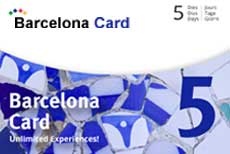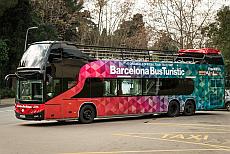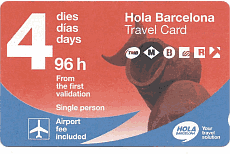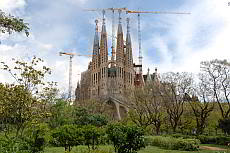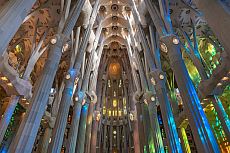Park Güell
Gaudí's homage to nature - let yourself be enchanted by the fairytale Park Güell
Marvel, relax, and enjoy: Welcome to Park Güell! The beautifully designed site, featuring the world-famous winding bench adorned with broken ceramic tiles, is one of Barcelona's most renowned landmarks and is considered Antoni Gaudí's homage to nature.
Contents of this page
We are absolutely thrilled by Park Güell and can hardly put into words how beautiful this landmark is. Step into this marvel and let yourself be enchanted!
Highlights of Park Güell
In Park Güell, architecture and nature merge in a breathtaking way. Immerse yourself in an incomparable masterpiece by Antoni Gaudí.
Magical gardens, mysterious paths, and colorful mosaics invite you to take a fascinating walk. Let yourself be enchanted by the unique vision of one of the greatest architects in history and experience a place full of vibrant atmosphere and creative design.
Does that sound exaggerated? Not to us. On the contrary, these words can only capture a fraction of how excited we are about Park Güell.
Enjoy the spectacular view over Barcelona and discover numerous fascinating architectural details that harmoniously blend with the surrounding nature. Curved benches, majestic columns, and playful mosaics make every step through the park an unforgettable experience. Park Güell is a place that invites you to marvel and dream—a true paradise for art and nature lovers alike.
Useful Tickets for Park Güell
There are various tickets and bookable offers for Park Güell that can make your visit more pleasant and interesting. Below is an overview of the most important tickets and events that you can choose based on your interests and needs.
- Enter Gaudí's dream world and his enchanting landscape, enjoy the magnificent view of Barcelona
- Ticket for entrance to the Monumental Zone of Park Güell
- Not included: Casa Museu Gaudí
- No printing required
- You can stay in the park until closing time
- Discover Gaudí's former residence and explore his creative retreat
- Skip-the-line access to the Monumental Zone of Park Güell
- Gaudí House Museum
- We recommend the Essential Pass because it includes two of Barcelona's most beautiful attractions: Park Güell and the Sagrada Familia, along with public transportation
- Hola BCN! ticket for 48, 72, 96, or 120 hours
- Skip-the-line entry to Park Güell
- Skip-the-line entry to Sagrada Familia
- Audio guide app for your smartphone
- Experience Gaudí to the fullest with this convenient combo ticket
- Skip-the-line entry to Park Güell
- Gaudí House Museum: Admission ticket
- Gaudí Experience: Exhibition + 4D cinema
- Discover the magic of Park Güell with a local expert
- Licensed professional local tour guide
- Skip-the-line entry to Park Güell
- Audio system and headphones for a better experience
- Languages: English ,French, Italian, Spanish, German
- Take a guided tour of Gaudí's extravagant parkno waiting in line!
- Skip-the-line access to the Monumental Zone of Park Güell
- 1.5-hour guided tour of the Monumental Zone
- Licensed guides
- Languages: English, French, Spanish
- The Barcelona Pass is a great package with interesting attractions
- Entry to Park Güell, optionally with a guided tour
- Entry to Sagrada Familia, optionally with tower access or a guided tour (in English)
- Ticket for Casa Milà, Casa Batlló, or the Bus Turístic
- Top attractions and free public transport
- Barcelona Card: free entries (e.g., Picasso Museum) and discounts for top attractions
72-120 hours - Free use of public transport, including the airport surcharge (72-120 hours)
- Entry to Sagrada Familia
- Entry to Park Güell
- The Gaudí Experience is incredibly fun. The 4D cinema is truly spectacular!
- Only a few hundred meters from Park Güell
- Journey with Gaudí to his works and through the world of Catalan Modernisme.
- With 7.1 surround sound, spatial images, and moving seats with special effects in 4D
- The Gaudí Experiència has two parts: a 17-minute 4D show and a 20-minute exhibition. The show features a giant screen with 7.1 surround sound, stereoscopic vision, and moving seats with special effects, allowing you to not only see but also feel with all your senses how Gaudí was inspired by the nature around him.
- It's just a mood booster
Getting to Park Güell
If you are arriving at Park Güell using public transport, please note that a walk is required.
- Metro Line L3 (Green Line): Get off at Lesseps station. From there, it’s about a 15-20 minute walk. Follow the main street "Travessera de Dalt" uphill until you reach "Avinguda del Santuari de Sant Josep de la Muntanya" on your left. Escalators partially assist the climb on this street. Follow the road to the end, where you'll see the entrance to Park Güell.
Do not get off at Vallcarca station. The escalators on Baixada de la Glòria, which lead to the park, are currently out of service, making access more difficult.
Tip for the return: On the parallel street to "Avinguda del Santuari de Sant Josep," "Carrer de Larrard," you’ll find the interactive 4D museum "Gaudí Experiencia", which is also located close to the park and is well worth a visit. - Arrival by Hop-on Hop-off buses: The "Park Güell" stop for the Bus Turístic (Blue Line) and the Barcelona City Bus (East Route, Green Line) are located on "Avinguda de la Mare de Déu de Montserrat." From there, it’s about a 10-minute walk to the park. The route is well signposted.
Architecture and green oases of Park Güell
The main entrance of Park Güell
The park's landmark is a salamander guarding the stairs to the market hall.
You will encounter it when you enter the park through the main entrance on the south side. Between the two pavilions, surrounded by turrets, you’ll immediately see a large staircase. Here, the friendly guardian of the park welcomes you - a salamander adorned with broken ceramics, known as Trencadís. Whether in the colorful and lively pavilions, the exotic salamander, or the decorated staircase, Gaudí's signature is evident everywhere.
Following the stairs will lead you to an unusual hall: consisting of 86 columns, it was originally intended to be the marketplace for a residential area.
Architectural Highlights of Park Güell
Make your own trencadís

Trencadís, the art of making mosaics from broken ceramics perfected by Gaudí, can also be learned. It’s not that difficult.
- The Dragon Staircase (Escalinata del Dragón) is named after the famous salamander sculpture in the middle of the ascent. It is adorned with colorful mosaic tiles (Trencadís) and is a symbol of Barcelona.
The dragon likely symbolizes the mythological guardian of the entrance to the Garden of the Hesperides. The staircase is not only an impressive piece of art, but it also serves to channel downpouring water into an underground cistern. - The Hypostyle Hall (Sala Hipòstila), located directly above the Dragon Staircase, was originally intended as a marketplace for the planned residential area in Park Güell. The 86 columns support the weight of the terrace with the undulating bench above the hall. Gaudí, who used nature as inspiration for his structures, created a structure with slanted columns that resembles an artificial forest.
Particularly noteworthy is the ceiling of the hall: It is decorated with circular mosaics in vibrant colors that depict the sun and other natural elements, enhancing the sense that the hall is a sacred place of nature. - The Wavy Bench (Banc de Trencadís or Serpentine Bench) is one of the most distinctive elements in Park Güell and runs along the edge of the large, open terrace above the Hypostyle Hall, a central spot in the Monumental Zone of the park.
The undulating, serpentine form of the bench allows visitors to sit either in groups or withdraw to quietly enjoy the breathtaking panoramic view of Barcelona and the sea.
Like many other elements in Park Güell, the bench is decorated with the Trencadís technique, where colorful, irregular ceramic pieces are assembled into mosaics. This technique, which uses recycled tiles, dishes, and other ceramic remnants, gives the bench its characteristic, vibrant color palette.
The ergonomically shaped backrest, designed by Gaudí, perfectly conforms to the human spine. This detail shows Gaudí's attention to human anatomy and his desire to create functional artworks.
The design of the bench was overseen by Gaudí himself, but it was executed in close collaboration with architect and artist Josep Maria Jujol. Jujol played a significant role in the creation of the mosaics, bringing his own creative vision to the project. - The Gaudí House (Casa Museu Gaudí) is a museum dedicated to the life and work of the famous Catalan architect Antoni Gaudí. Located directly in the park, it was Gaudí's residence from 1906 to 1925. In 1925, he moved to the Sagrada Familia to fully dedicate himself to the construction of the church.
Although the house was not designed by Gaudí himself, but by his collaborator Francesc Berenguer i Mestres, it is a fine example of Catalan Art Nouveau (Modernisme). It features many of Gaudí's typical decorative and design elements, albeit with less extravagance than his most famous works.
The Gaudí House has been a museum since 1963 and houses a collection of furniture, artworks, drawings, and personal items of Gaudí, including furniture he designed for other buildings. Works by artists and architects who collaborated with him are also on display.
The garden, designed in Gaudí's style, offers a tranquil atmosphere and underscores the special character of the place.
Enchanted Green Spaces
The green space of Park Güell is a carefully and originally integrated maze of paths, arcades, viaducts, walls, and bridges. Gaudí succeeded in blending his architecture harmoniously with the natural surroundings, incorporating the forms of nature into his design. The result is a fairytale garden full of lovingly crafted details, inviting you to explore.
Interesting Information for Visiting Park Güell
It is worth planning enough time for your visit to leisurely stroll through and enjoy the beauty of the park.
- The Austrian Gardens (Jardins d'Àustria) demonstrate how Park Güell continued to develop after Gaudí's time. They received their name from a donation of plants from Austria in the 1970s, which contributed to the beautification of this part of the park.
The area of today's Austrian Gardens was originally intended for residential houses, as the park was planned as a settlement with 60 houses. However, this project was never fully realized, and only two houses, including the current Gaudí House, were actually built.
The design of the gardens is characterized by a diverse plant life that represents different climate zones and landscapes. It harmoniously integrates into the organic aesthetic of the rest of the park, although it contains few architectural elements by Gaudí. The Austrian Gardens offer a peaceful retreat away from the main attractions of Park Güell. - The Viaducts in Park Güell contribute significantly to the unique atmosphere of the park. They not only provide practical paths through the area but are also an integral part of Gaudí's visionary landscape design. Here, architecture and nature blend harmoniously.
The viaducts use organic forms that mimic trees, roots, and other natural structures, blending seamlessly into the environment. Among the largest viaducts are the "Viaducte de les Bugaderes" and the "Viaducte del Algarrobo." Each of these viaducts has its own style and character, ranging from robust to delicate. - The Paths are cleverly integrated into the topography of the land. They wind through the park, offering visitors a relaxing and at the same time impressive experience. Gaudí designed the paths to follow the natural contours of the hill, avoiding steep ascents or descents.
- The diversity of plants in Park Güell significantly contributes to its unique atmosphere. The carefully selected Mediterranean plants, including trees like pines and palms, as well as fragrant shrubs like lavender and rosemary, are harmoniously integrated into Gaudí's architectural elements. This lush vegetation not only provides visual beauty and shade but also enhances the park's fairy-tale ambiance. Visitors can immerse themselves in a varied and picturesque plant world, offering an unforgettable experience.
History of Park Güell
The fascinating history of Park Güell is closely linked with the visionary architect Antoni Gaudí and his patron Eusebi Güell.
- Inspired by the English garden city movement, Eusebi Güell, a wealthy industrialist and great supporter of Antoni Gaudí, wanted to create a luxurious residential complex. This exclusive settlement for Barcelona's wealthy citizens was intended to consist of about 60 private villas, surrounded by generous green spaces and communal areas.
- Güell commissioned Antoni Gaudí, who had previously worked for him, to design and plan the entire project. Gaudí designed the roads, viaducts, public squares, and landscape architecture of the park. He combined innovative architecture with a deep connection to nature, which is reflected in the park's organic design.
- The construction phase began in 1900, and Gaudí skillfully used the topography of the site to create a harmonious integration of architecture and nature. Despite the impressive plans, the sale of the plots proceeded slowly, so only two houses were ultimately built, including the now-famous Gaudí House (Casa Museu Gaudí), which was not designed by Gaudí himself.
Due to the lack of demand, the original garden city project was eventually abandoned. - After the death of Eusebi Güell in 1918, the land was sold by his family to the city of Barcelona in 1922. Park Güell was opened as a public park in 1926, the year of Gaudí's death.
- Gaudí's former residence was opened as a museum in 1963.
- In 1984, Park Güell, along with other works by Gaudí, was declared a UNESCO World Heritage Site. Today, Park Güell, along with the Sagrada Familia, Casa Milà, and Casa Batlló, is one of Barcelona's most important and visited attractions.
Why a Visit to Park Güell is Worthwhile
We can hardly put the beauty of this impressive landmark into words. The entire park is lovingly designed and surprises with enchanting details. From the park, you have a wonderful view of Barcelona, all the way to the sea.
Here you can take a peaceful stroll away from the hustle and bustle, enjoy nature, and admire Gaudí's masterful architecture. Don't miss the opportunity to experience this unique place.
Tickets and guided tours of Park Güell
(Click on the product images to view prices and availability)
Important information
Surroundings
Find Hotels nearby
Address
Carrer d'Olot
www.parkguell.cat/en/
Arrival
Metro: Lesseps (L3) + 10 min. walking distance
Bus Turístic: Park Güell
Parking nearby
Tips for the visit of the Park Güell
Schedule about 2 to 3 hours for the visit.
Book your accommodation in Barcelona here! All categories.
1-5*-hotel rooms, apartments, hostels.

